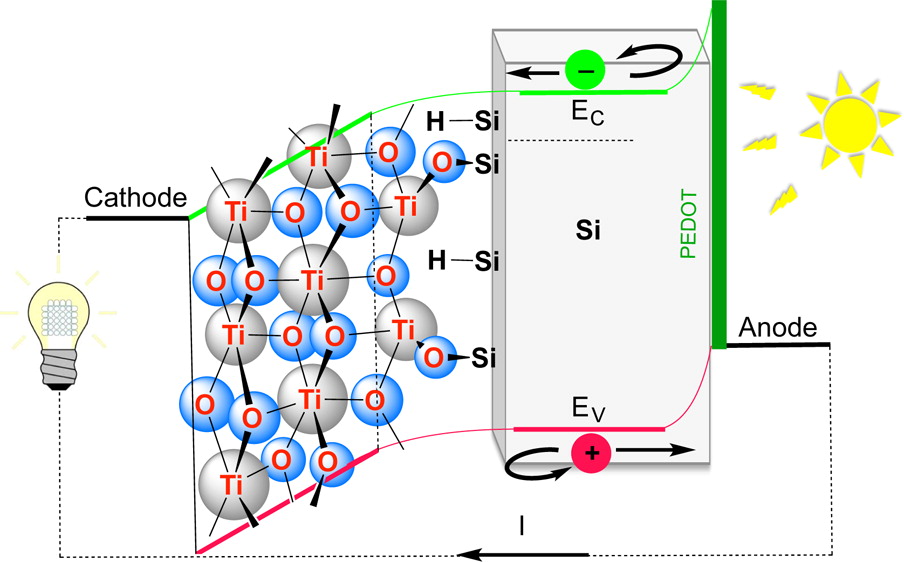Scientists report low-temperature synthesis of efficient solar cell interface
A team of researchers at Princeton University has developed a simple, low-temperature method to synthesize an efficient solar cell interface. The interface plays a critical role in converting sunlight to electrical energy.
When light strikes a solar cell, electrons in the material are excited to a higher energy level and result in electron-hole pairs. To yield electricity, the electrons and holes are separated and directed towards opposing contacts using so-called ‘hole-blocking’ and ‘electron-blocking’ materials.

Copyright © 2015, American Chemical Society
Reported in the Journal of the American Chemical Society, researchers deposited a thin ‘hole-blocking’ layer of titanium dioxide on a hydrogen-capped silicon surface to form a TiO2/Si interface whose performance matched the leading classic interface, SiO2/Si. The interface was synthesized at 100 °C, much lower than the ~800 °C temperatures typically required.
“The drawback of using high temperatures is that it’s slow, inefficient and expensive,” said Jeffrey Schwartz, professor of chemistry and corresponding author on the work.
Titanium dioxide is an attractive material because it’s cheap and abundant and is already being produced in large-scale thin film applications, such as self-cleaning smart windows. TiO2 has also been recognized for its desirable electronic properties, but other groups have had difficulties successfully integrating it into solar cell devices. Girija Sahasrabudhe, a graduate student in the Schwartz lab and first author on the article, found that the key to making an effective TiO2 layer was rigorous exclusion of air.
The research team hypothesized that their technique allowed a new type of Si-O-Ti species to form at the interface, which provided the intimate contact needed to block the holes. The method also decreased the number of gap states in the interface, which are sites where electrons and holes can recombine, essentially rendering them useless.
To implement their method in an actual device, Sahasrabudhe and Schwartz worked with a multidisciplinary team, including scientists from the Department of Electrical Engineering at Princeton and the Princeton Institute for the Science and Technology of Materials.
“We have a beautiful group,” Sahasrabudhe said, “everyone has different expertise, and we come together to tell these stories.”
Read the full article here:
Sahasrabudhe, G.; Rupich, S.M.; Jhaveri, J.; Berg, A. H.; Nagamatsu, K. A.; Man, G.; Chabal, Y. J.; Kahn, A.; Wagner, S.; Sturm, J. C.; Schwartz, J. “Low-Temperature Synthesis of a TiO2/Si Heterojunction.” J. Am. Chem. Soc., 2015, 137, 14842.
This work was supported by the United States Department of Energy Sunshot Program (DE-EE0005315), the National Science Foundation Princeton MRSEC (DMR-0819860), the National Science Foundation (CHE-1300180), and the Princeton Institute for the Science and Technology of Materials, and the Princeton Andlinger Center for Energy and Environment for support of this research.
